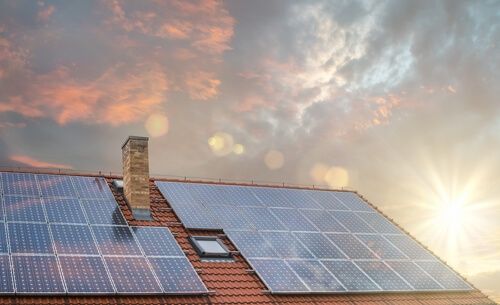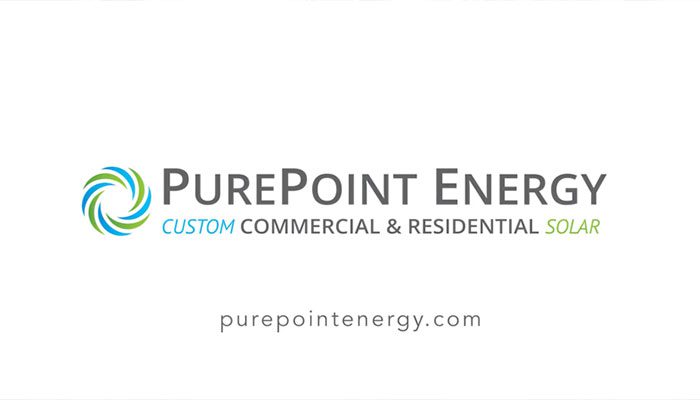Solar Financing for Nonprofits with Collective Sun
March 18, 2019
Fighting Global Warming With Solar Energy | PurePoint Energy
May 6, 2019Solar Financing for Nonprofits with Collective Sun
March 18, 2019
Fighting Global Warming With Solar Energy | PurePoint Energy
May 6, 2019In this blog we will discuss the most common roof types suitable for both commercial solar. Knowing and understanding the condition, pitch, and the age of your roof are determining factors in whether or not you are ready to go solar. If your roof is over 5 years old for instance, you may want to consider having a professional evaluate the roof to determine if it is indeed suitable and ready for solar panels. If you are constructing a new build or replacing your commercial roof, here are the most common materials and membranes used when incorporating solar PV.
What Are the Basic Roofing Requirements for Installing Solar Panels?
Before you can even see whether your roofing type is best for solar panel installation, it's important to ensure that you meet the basic requirements. First, you need to ensure that your roof faces south or south east to ensure that it will receive enough direct sunlight to adequately absorb enough solar energy to meet your electrical demands.
Next, you need to ensure that your property's roof is free from shade caused by trees, neighboring properties or buildings, landscaping, or chimneys. Too much shade can render an entire section of panels ineffective.
The Best Roof Types for Solar Panels
Composite Roofs:
- Most common roofing material.
- Composite shingles or asphalt shingles are made of fiberglass or cellulose mat. Asphalt is added in the final product.
- The cost is cheap and the material is durable.
- One of the best options for installing solar.
Tile Roofs:
- Types of tiles can vary in price. Ex – clay is more expensive to install than concrete tiles.
- When installing solar, panels must be attached in a way that will lift the panels slightly above the roof.
- This is labor intensive and extra matching tiles should be available
Metal Standing Seam Roofs:
- The best roof type to install solar.
- The standing seams make attaching the solar array very easy.
- Easy installation means cheaper cost.
- No holes being drilled into the roof.
- Durable and can last over 30 years.
- Eco-friendly because it is made of recyclable material.
- When selecting a metal standing seam roof, make sure to coordinate with your solar installer to insure the gauge (thickness) of the metal is rated for the roofing clamps.
- An engineer should be consulted to confirm that the roof is sufficiently attached to the structural trusses or rafters. The solar panels often are only connected to the roofing panels. Because the panels are raised off of the roof, there is additional uplift forces that if not properly accounted for could lift the panels and the roof off of the structure.
Tar and Gravel Roofs:
- Gravel and tar are most likely to be found on flat roofs.
- Made of layers of sheets that are attached with hot tar and roofing felt.
- Needs additional brackets because of the lack of pitch. Will need to be tilted on a 0 - 30 degree angle depending on design constraints.
- It may be possible to do a ballasted, non-penetrating, racking solution if the structure is capable of additional weight. Ballasted solar arrays are typically weighed down with concrete blocks that are engineered for specific climate where the array will go. It is important in areas that freeze to use specific types of concrete or the concrete will break down over time. Depending on wind and snow loading, ballasted arrays can add up to 12 psf to the roof.
- In cases where the roof cannot handle additional loading, a mechanically attached solar racking system or a hybrid of a ballasted and mechanically attached system may be the proper solution.
Cedar Shake Roofs:
- These roofs are some of the most difficult to install and require a very experienced solar installer with cedar shake experience or an experienced cedar shake roofer to make the attachments
- Special flashings are required, roofing nails must be removed without damaging the cedar shake
- This type of roof is time consuming and more expensive to add solar to, but it can be done.
- Some homeowners opt to replace the portion of roof where solar will go from cedar shake to asphalt shingles. The area underneath the solar panels will not be visible, so it could be possible to keep the aesthetics of the home uniform.
The Best Commercial Roofing Types For Solar Panels
Commercial PVC Roofs:
- Advantages are durability, longevity, and fire retardant properties.
- Membranes have been flame tested and can work to self-extinguish.
- Resistant to moisture, wind, and chemicals as well as being puncture and tear resistant.
- Highly energy efficient due to insulation and reflective properties. Reduces cost to heat and cool.
- Higher upfront cost compared to other materials but it is a small price to pay for the durability, longevity, fire resistance, energy efficiency, and warranty benefits of the product.
Commercial Metal Retrofitting Roofs:
- Metal greatly extends the life of the roof.
- Retrofitting is eco-friendly due to less scrap materials that end up as landfill waste.
- Takes advantage of reusing your current roof insulation as well as the additional insulation from the membrane.
- Saves on energy costs and keeps the building temperature regulated.
- Complete metal roofing installs generally last 30-60 years and come at a cost increase.
- Retrofitting is more cost effective than a complete metal roof.
Commercial EPDM Roofs:
- Most EPDM roofs are black but can come in white coating which will help reflect the sun’s heat and potentially increase solar production.
- Easily stretches and fits over roof.
- Because it’s been on the market for over 60 years, it has a good track record as a roofing material.
- Provides weather protection with highly durable rubber. The seams are closed with seam tape or an adhesive.
- The owner has many options for insulation because the membrane does not have any.
- Hot weather can cause material to shrink and can also cause tears which lead to water leaking under the membrane.
- Adhesive and seam tape can degrade from UV sunlight, also leading to leaks.
- Having an experienced roofer is important for proper installation, maintenance and repairs. Will help membrane last longer.
Commercial Thermoplastic Polyolefin (TPO) Roofs:
- Cheaper upfront cost.
- Durable and flexible. Can make custom edge-to-edge fabrication simpler and more efficient.
- Flexibility helps the material stretch and adapt to your building’s movement and setting.
- Material has not been used for long, its longevity is still in question.
The Best Roof Pitches for Solar Panels
Flat Roofs:
materials and membranes are rubber rolled roofing, TPO, and EPDM.
Pros:
- More cost effective because they require less material due to fewer square feet to be covered.
- Easy and quick installs.
- Less visible from the street.
- Easy maintenance because of the ability to walk on safely.
Cons:
- Poor drainage – standing water can degrade the materials long before they should.
- To avoid future problems, be sure to work with an experienced roofer with a good reputation.
Low-Sloped Roof:
materials and membranes are rubber rolled, TPO, EPDM.
Pros:
- Requires less square footage of roofing materials.
- Easy and safer conditions for roofers to work on (installation and repair).
- Allows for water runoff – design directs water where it should go with valleys, saddles, and drains.
Cons:
- Heavy snow does not melt quickly and can add weight stress to the roof.
- Building codes regarding low-sloped roof for your area must be adhered to precisely.
Pitched Roof:
materials and membranes are asphalt shingles, tile, metal, and wood shingles.
Pros:
- Increased slope provides greater runoff for debris, water and snow. Less risk for water buildup that can lead to leaks and mold damage.
- Can reduce the amount of repair and maintenance costs from a flatter, less inclined roof.
Cons:
- More difficult to perform maintenance and repair due to steep pitch.
- Need for more safety procedures, transferring materials and difficulty maneuvering around the roof generally increases the costs of installation, repair or maintenance.
PurePoint Energy is a knowledgeable solar installer that has extensive experience in working with both commercial roof installations. If you are looking for a trusted local company that is dedicated to providing you with premium service, please consult with us by calling (203) 989-2905 or contacting us online for your free solar evaluation. No matter what your roof type, we can help you make the best decision to improve your property and lower the cost of operation, if it is indeed suitable for solar PV.


